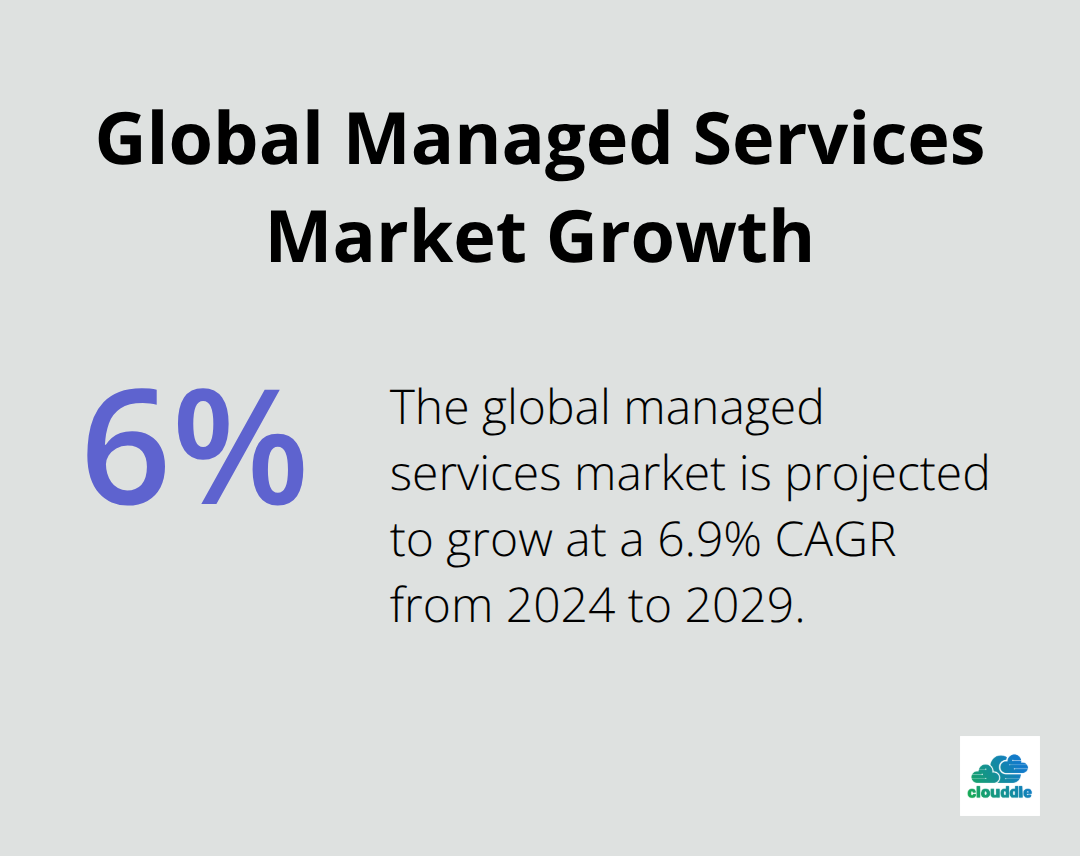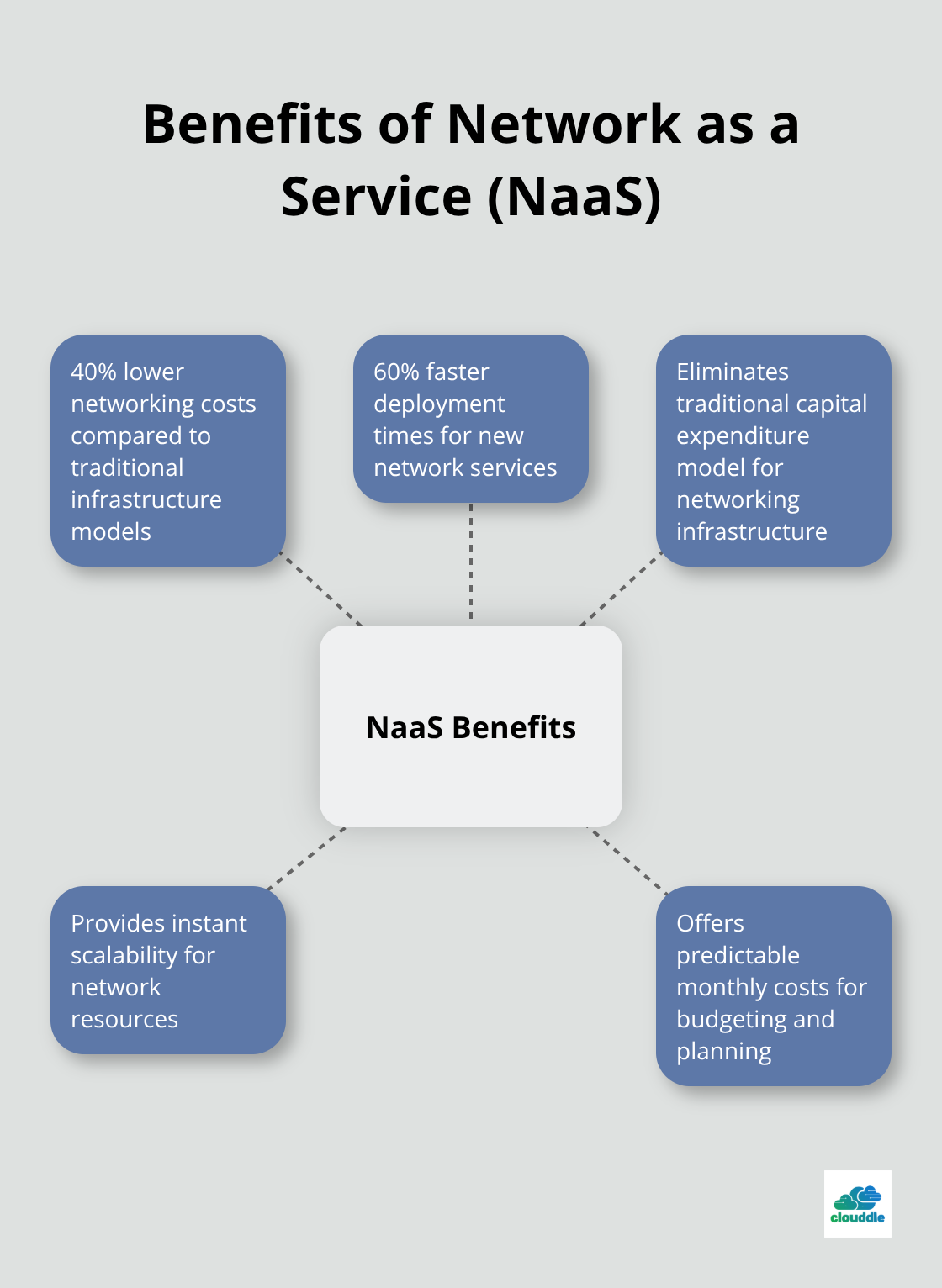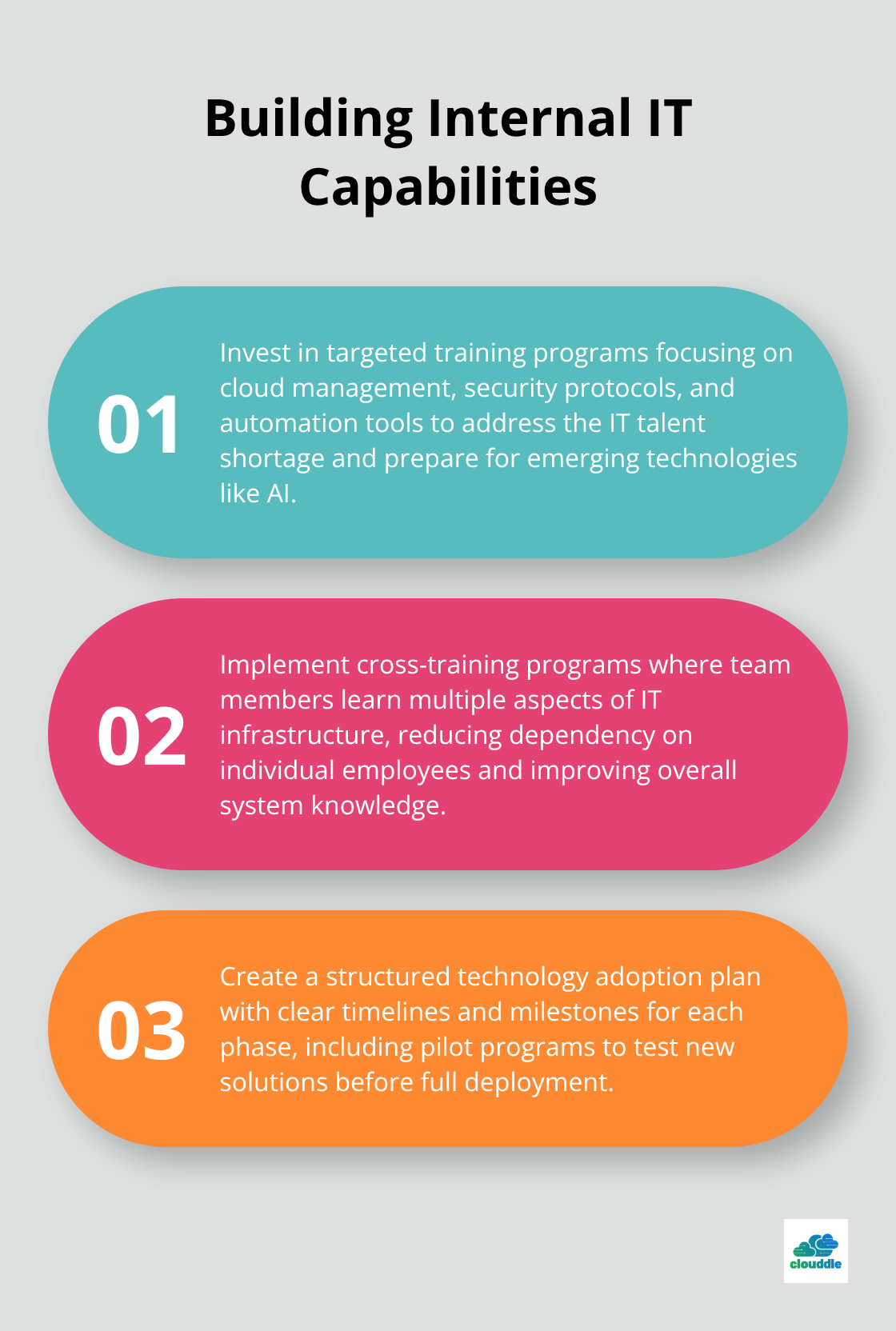The future of IT managed services is transforming at breakneck speed. Cloud adoption, AI automation, and advanced cybersecurity are reshaping how businesses operate their technology infrastructure.
We at Clouddle see companies struggling to keep pace with these rapid changes. Smart preparation today determines which organizations will thrive tomorrow in this evolving landscape.
What Trends Are Reshaping IT Managed Services Now
Cloud Infrastructure Becomes Non-Negotiable
The shift to cloud-first strategies isn’t optional anymore. The global managed services market is estimated to grow from USD 365.33 billion in 2024 to USD 511.03 billion by 2029 at a CAGR of 6.9%, with cloud services driving most of this growth according to industry reports. Companies that implement hybrid infrastructure see 30% faster deployment times compared to traditional on-premises setups.

Multi-cloud strategies are now standard practice. Organizations use multiple public and private cloud services simultaneously to avoid vendor lock-in and improve resilience. Smart businesses move beyond basic cloud migration to adopt Infrastructure as a Service models that provide predictable costs and instant scalability.
AI Integration Transforms Service Delivery
Artificial intelligence has moved from experimental to essential in managed services. The Channel Company found that 48% of solution providers now offer AI consulting services, which marks a dramatic shift in how MSPs operate.
AI-powered systems predict equipment failures weeks before they occur (reducing downtime by up to 40%). Generative AI tools streamline everything from network troubleshooting to security incident response. Companies that use AI-enhanced managed services report 25% faster issue resolution times and significantly improved customer satisfaction scores.
Security Becomes the Foundation
Cybersecurity has evolved from an add-on service to the core foundation of all managed services. Organizations without security AI and automation face average breach costs of $5.72 million, while those with proper security measures see dramatically lower costs according to IBM’s Cost of a Data Breach Report.
Zero-trust frameworks are becoming mandatory, not optional. MSPs integrate advanced threat detection, automated incident response, and continuous compliance monitoring into every service package. The days of treating security as a separate line item are over – it’s now embedded in every aspect of IT infrastructure management.
Compliance as a Service Gains Momentum
The Compliance as a Service market is expected to grow from $7.55 billion in 2023 to $26.75 billion by 2032. Approximately 80% of service providers offer some form of compliance services, though only 15% deliver it primarily as a managed service.
Companies need continuous compliance monitoring rather than annual audits. MSPs now provide year-round compliance management that addresses regulatory requirements in real-time. This shift helps organizations maintain compliance without dedicating internal resources to complex regulatory frameworks.
These fundamental changes in managed services create new opportunities for businesses ready to adapt. The next step involves understanding which specific technologies will drive the most significant transformations in the coming years.
Which Technologies Will Define Managed Services Tomorrow
Network as a Service Transforms Infrastructure Management
Network as a Service represents the most significant shift in infrastructure management since cloud computing emerged. The multi-cloud management market was estimated at $8.03 billion in 2022 and projects growth at a 28% CAGR through 2030 according to industry research.
NaaS eliminates the traditional capital expenditure model by delivering networking, security, and connectivity as a unified service. Organizations that use NaaS report 40% lower networking costs and 60% faster deployment times compared to traditional infrastructure models.

This approach bundles networking, entertainment, and security without requiring initial capital investment. Companies can scale their infrastructure instantly while maintaining predictable monthly costs.
Predictive Analytics Prevents System Failures
While machine learning shows promise for system monitoring, 85% of machine learning projects actually fail due to inadequate data quality and unrealistic expectations. MSPs that use advanced monitoring tools identify performance anomalies weeks before issues escalate, reducing unplanned downtime significantly.
Real-time analytics platforms process millions of data points per second to detect patterns that human technicians would miss. These systems analyze network traffic, server performance, and user behavior to predict problems before they occur.
The technology allows IT teams to shift from reactive troubleshooting to proactive maintenance. This fundamental change reduces emergency support calls and improves overall system reliability.
Zero Trust Security Becomes Standard Practice
Zero-trust security frameworks have become mandatory rather than optional for modern organizations. Companies implement continuous verification protocols that validate every user and device attempting network access.
Organizations that adopt zero-trust architectures experience 50% fewer security incidents and contain breaches nearly 100 days faster than those using traditional perimeter-based security models. The framework assumes no implicit trust and verifies every transaction.
This security model works particularly well with remote work environments where traditional network perimeters no longer exist. Every access request receives scrutiny regardless of location or device type.
These technological advances create the foundation for more sophisticated managed services. The next step involves preparing your organization to leverage these innovations effectively while maintaining operational continuity.
How Do You Prepare Your Organization for Future IT Demands
Conduct a Comprehensive Infrastructure Assessment
Most organizations operate with outdated systems that create vulnerabilities and inefficiencies. Start with a detailed audit of your current hardware, software licenses, and network architecture. Document every server, workstation, and network device along with their age and performance metrics. Infrastructure audits provide comprehensive benefits including identifying optimization opportunities and improving system reliability.
Focus on single points of failure in your network infrastructure. Map out data flows, backup systems, and recovery procedures to understand where gaps exist. Organizations with properly documented infrastructure recover from outages significantly faster than those without comprehensive documentation.
Select Service Providers with Adaptive Contract Models
Traditional managed service contracts lock organizations into rigid agreements that cannot adapt to business needs that change. The subscription-based service model provides predictable costs while it offers flexibility to adjust services as requirements evolve. Most companies now expect their service providers to act as strategic collaborators rather than just technical vendors.
Look for providers who offer modular services that can scale up or down based on your needs. Avoid contracts that penalize you for service level changes or new technology additions. The best providers offer month-to-month flexibility for additional services while they maintain core infrastructure support under longer-term agreements.
Build Internal Technical Capabilities
The IT talent shortage affects every industry, which makes internal capability development more important than ever. Business leaders feel increasing pressure to implement AI, but many lack the skills to do so effectively. Invest in programs that focus on cloud management, security protocols, and automation tools rather than generic technology courses.
Create cross-training programs where team members learn multiple aspects of your IT infrastructure. This approach reduces dependency on individual employees and improves overall system knowledge. Organizations with cross-trained IT teams experience fewer service disruptions during personnel changes compared to teams with specialized roles only.

Plan for Technology Integration Phases
Smart organizations implement new technologies in phases rather than all at once. Start with pilot programs that test new solutions on a small scale before full deployment. This approach reduces risk and allows you to identify potential issues before they affect your entire operation.
Establish clear timelines for each technology adoption phase. Set specific milestones for cloud migration, security upgrades, and automation implementation. Organizations that follow structured technology adoption plans complete projects faster than those who attempt comprehensive overhauls.
Final Thoughts
The future of IT managed services demands immediate action from forward-thinking organizations. Cloud-first strategies, AI automation, and zero-trust security frameworks will separate industry leaders from those left behind. Companies that wait for these technologies to mature risk falling irreversibly behind their competitors.
Organizations must conduct comprehensive infrastructure audits to identify gaps and vulnerabilities. Smart businesses choose service providers who offer flexible contracts and modular solutions that adapt to their needs. Staff training programs should focus on cloud management, security protocols, and automation tools rather than generic technology courses.
Organizations that embrace these changes now will experience reduced operational costs, improved security posture, and faster response times to market opportunities (the managed services market’s projected growth to $511 billion by 2029 reflects this massive transformation). We at Clouddle help businesses navigate this technological shift through our Network as a Service solutions that combine networking, entertainment, and security without requiring initial capital investment. These solutions maintain operational continuity while businesses adapt to the evolving landscape of managed services.


